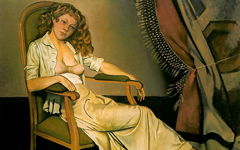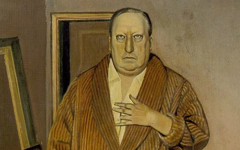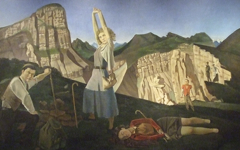Balthus’ The Moroccan Rider with His Horse (1935)

Balthus, The Moroccan Rider and His Horse (1935) oil on canvas. Musée Jenisch, Vevey
Click image to enlarge.
Balthus painted a horse's head as though it was an anthropomorphic portrait, a sculpted bust, erect, upright and in profile. The rider, clearly less important, is dressed in a high hat like a figure by Piero della Francesca whose works Balthus had copied.1 What, then, is he up to? Regular readers know that a prominent animal by a significant artist should first be compared for physiognomic likeness to the artist's self-portraits or, if available, to photographs too. And the horse does indeed resemble Balthus in a Man Ray photo from 1933.
Click next thumbnail to continue

L: Detail inverted, with diagram, of Balthus' The Moroccan Rider (1935)
R: Man Ray, Portrait of Balthus, detail and diagram (1933) Photograph.
Click image to enlarge.
Given Man Ray's stature and the recent date, this may be the actual image on which Balthus based the horse's head. They both share a firm jaw with a long, pencil-thin mouth, a long, straight nose with a flared nostril, and a similarly angled eye-opening. Compare the colored marks on the horse (below) to marks of similar color on Balthus'. Like so many artists, he seems to convey that all mankind is at one with nature and that instincts, emotions and appetites need training and discipline if we are to behave ethically and avoid the psychological calamities of life.
Click next thumbnail to continue
Note also the odd lines on the horse's cheek (left). Being unsual, they must be intentional and almost certainly have meaning. My suggestion is that they imitate two letter Bs for Balthus, back to back with the left-hand side inverted as in a mirror. If it's a monogram, it either conveys the duality of existence or the mirror-image of the mind, and conceivably both. The Bs are, after all, stamped on his own likeness like a rancher's brand.
Click next thumbnail to continue
Now to the man in the Piero-like headwear with a smile of spiritual purity.2 He is theoretically the "artist" who has "sculpted or painted" the horse as a work of art.3 However, easy to miss, are the eye-like marks on either side of his jacket at the lower edge (bottom). As in works already shown by Picasso, Matisse, Giacometti and before them Holbein, they are the artist's "eyes" out of which the "painting" emerges above. Here (below) one has a pupil for exterior vision, the other is all black for insight. Whatever these "eyes" perceive, presumably the artist in front of his easel, is drawn up through visual metaphor into the light gray, chimney-like shape of his shirt and onwards into the man's neck and then head. The artist's self-perception thus merges into a mental image in the "mind" of the horseman-artist above. And, as a logical consequence, his self-image is fused with a horse.
Click next thumbnail to continue
Although this is likely a Moroccan hat, it also refers to other hats in art, some of which by Rembrandt we have shown. Positioned above the head, they often signify mental activity.4 In this case, the hat also recalls the bristle-head of a paintbrush as seen in the constructed diagram. Intellect and craft must be united. In summary then, the self-perception of Balthus' "eyes" at bottom passes through the rider's mind where it merges with the image of a horse. It is then chanelled through his paintbrush-hat to the work of art itself, the artist as a white horse which in itself is full of mythic meaning. But you can research that for yourself.
More Works by Balthus
Notes:
1. Among Balthus' early copies after Piero della Francesco are the men in high hats in the Renaissance artist's Heraclitus Taking the True Cross to Jerusalem.
2. In many spiritual traditions, the smile represents spiritual purity as in, for instance, the smile of the Buddha. In the Christian tradition Leonardo da Vinci used smiles for a similar purpose in his images of St. John the Baptist and Archangel Gabriel and, in my opinion, the Mona Lisa as well.
3. In conformity to the paradigm that every painter paints himself, a philosophical truth, the "real" horse which was the "model" - and is now a "painting" - also represents the artist because we, as humans, can only perceive other beings as in some sense ourself. In other words, it is our belief that in most, if not all true art, the artist and model are one. If they do not seem to be, we have not yet seen how.
4. See our entry on Rembrandt's Beggar in a High Cap (c.1629).
Original Publication Date on EPPH: 15 Jan 2016. © Simon Abrahams. Articles on this site are the copyright of Simon Abrahams. To use copyrighted material in print or other media for purposes beyond 'fair use', you must obtain permission from the copyright owner. Websites may link to this page without permission (please do) but may not reproduce the material on their own site without crediting Simon Abrahams and EPPH.






